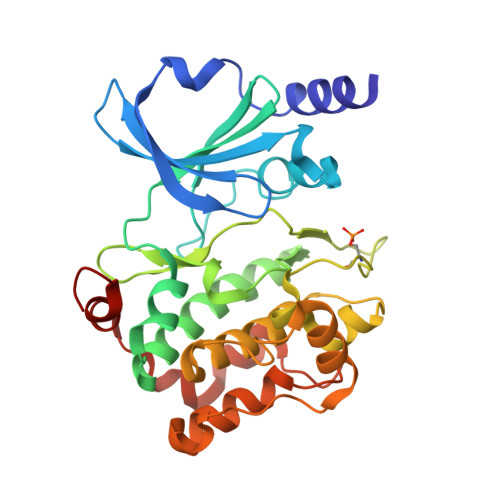Back Pocket Flexibility Provides Group II p21-Activated Kinase (PAK) Selectivity for Type I 1/2 Kinase Inhibitors.
Staben, S.T., Feng, J.A., Lyle, K., Belvin, M., Boggs, J., Burch, J.D., Chua, C.C., Cui, H., Dipasquale, A.G., Friedman, L.S., Heise, C., Koeppen, H., Kotey, A., Mintzer, R., Oh, A., Roberts, D.A., Rouge, L., Rudolph, J., Tam, C., Wang, W., Xiao, Y., Young, A., Zhang, Y., Hoeflich, K.P.(2014) J Med Chem 57: 1033-1045
- PubMed: 24432870
- DOI: https://doi.org/10.1021/jm401768t
- Primary Citation of Related Structures:
4O0R, 4O0T, 4O0V, 4O0X, 4O0Y - PubMed Abstract:
Structure-based methods were used to design a potent and highly selective group II p21-activated kinase (PAK) inhibitor with a novel binding mode, compound 17. Hydrophobic interactions within a lipophilic pocket past the methionine gatekeeper of group II PAKs approached by these type I 1/2 binders were found to be important for improving potency. A structure-based hypothesis and strategy for achieving selectivity over group I PAKs, and the broad kinome, based on unique flexibility of this lipophilic pocket, is presented. A concentration-dependent decrease in tumor cell migration and invasion in two triple-negative breast cancer cell lines was observed with compound 17.
Organizational Affiliation:
Department of Discovery Chemistry, ‡Department of Translational Oncology, △Department of Pathology, §Department of Drug Metabolism and Pharmacokinetics, ∥Department of Biochemical and Cellular Pharmacology, and ⊥Department of Structural Biology, Genentech, Inc. , 1 DNA Way, South San Francisco, California 94080, United States.
















